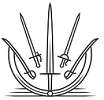Tournament participants must follow the directions of the tournament director and staff at all times. Any participant exhibiting behavior that places themselves or others at risk of harm will result in immediate disqualification and possible intervention by local law enforcement.
- Tournament Goals
- Safety Regulations
- Equipment
- Longsword Cutting Patterns
- Arming Sword Cutting Patterns
- Quality Standards
- Competitor Conduct
Tournament Goals
The goal of the SoCal Swordfight cutting tournaments is to:
- Showcase/evaluate/reward sword skills that can not be tested in a sparring environment.
- Promote an integrated training regiment, with good cutting mechanics in sparring and good fencing behavior in cutting
- Be creative, educational, and enjoyable for both participants and spectators.
Safety Regulations
All competitors will be required to assume proper safe-handling procedures for sharp swords. This includes, but is not limited to:
- Follow the instructions of the tournament staff without hesitation or argument, including approaching the target from the specified direction.
- Maintain an awareness of surroundings at all times, and not under any circumstances swing the sword in the vicinity of others.
- Ensure hands and hilt are dry before wielding a sword. Competitors are not to handle mats at any time during the tournament without explicit instruction from staff.
- Do not cut before the tournament staff indicate that they are ready for you to begin.
- Be aware of the sharp swords potential for injury if used without the proper respect and safety protocols.
- Not extend the off-hand forward away from the body while cutting. Keep it next to or behind the torso. (Arming sword only)
Should the tournament officials perceive that there is any safety issue, they retain the right to remove individuals from the cutting tournament at their discretion.
Competitors are forbidden to cut toward their lead leg with Descending Cuts.
(Competitors in Tier-A Cutting are free to cut in any direction.)
Equipment
There will be loaner swords available for both longsword and arming sword. Competitors are permitted to bring their own sword provided they conform to the tournament guidelines.
European longswords and arming swords only. No messers, no sabers, no zweihanders, etc. If you are using something that isn't sold as a longsword or arming sword by a reputable European sword manufacturer you must get approval for the sword.
The tournament is under no obligation to let you use a sword that you've brought.
Cutting Qualification
Information on the Cutting Qualification can be found in the Longsword Rules.
Longsword Cutting Patterns
Tier-C Cutting Patterns
Round 1 - Descending Cuts
Target 1 - Single Tatami Roll
Competitors will perform 3 descending cuts on each side, in any order. (6 total cuts)
Target 2 - Hanging Paper
Competitors must perform 6 descending cuts, 3 on each side.
Top 25 by score will advance to the next round.
Round 2 - More Cuts
Target 1 - Single Tatami Roll
Competitors will perform 3 ascending cuts on each side, in any order. (6 total cuts)
Target 2 - Hanging Paper
Competitors must perform 3 descending cuts, on the same side, in a continuous motion. This will be repeated on both sides.
The recovery between swings need not be fast, but should show no signs of hesitation.
Top 4 by cumulative score advance to the Final Round.
Round 3 - Reactive Cutting
Target 1 & Target 2 - Single Tatami Roll
Competitors will perform cuts as prompted by the tournament staff. (Single tatami mat).
Eligible cuts:
- Descending Right
- Descending Left
- Ascending Right
- Ascending Left
Longsword Tier-B Cutting Patterns
Round 1 - Continuous Cuts
Target 1 - Single Tatami Roll
Competitors will perform a total of 6 cuts, alternating between true edge descending and ascending along the same line. Cuts must be performed in a continuous pattern with no delays to recover/re-chamber between. Example↓
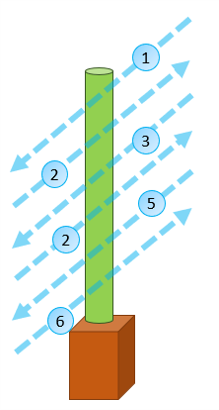
Target 2 - Single Tatami Roll
Competitors will perform a total of 6 cuts, alternating between true edge descending and ascending along the opposite line as Target 1. Cuts must be performed in a continuous pattern with no delays to recover/re-chamber between. Example↓
Top 12 by score will advance to the next round.
Round 2 - Reactive Cutting
Target 1 & Target 2 - Single Tatami Roll
Competitors will perform cuts as prompted by the tournament staff.
Eligible cuts:
- Descending Right
- Descending Left
- Ascending Right
- Ascending Left
Top 4 by cumulative score advance to the Final Round.
Round 3 - Cutting Feats
Feat 1 - Avenger Single Tatami Roll
Target 1 will be a single tatami mat oriented at a 45-degree angle. The competitor must perform as many of the eligible strikes as possible, with each cut only being attempted a single time. These cuts are intended to be performed in a vertical line, and large deviations from vertical will be penalized. Example↓
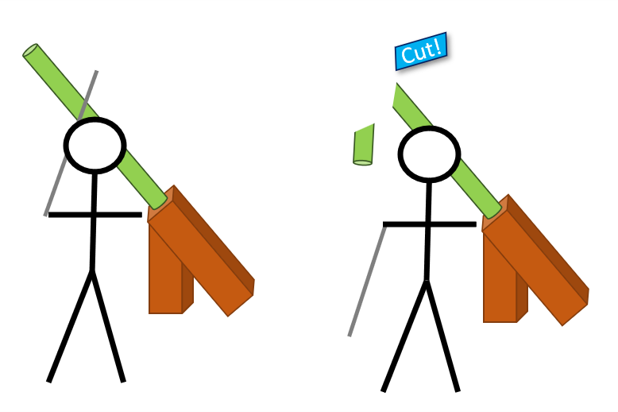
Eligible Cuts:
- Krumphau* (R/L)
- Shielhau (R/L)
- Schietalhau (Single)
Feat 2 - Draw To The Button
Competitors will be presented a sheet of hanging paper with 6 dots marked on it. They will perform each of the 6 basic cuts with the aim of bringing the sword to rest as close to the target dot as possible. Example↓
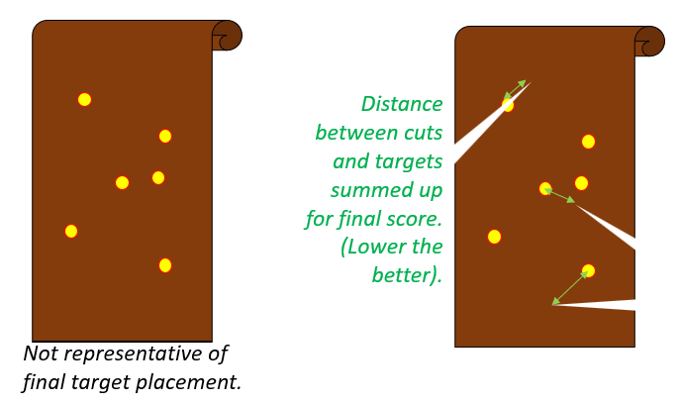
Longsword Tier-A Cutting Patterns
Round 1- Reactive Cutting
Target 1 - Dowel + Tatami Roll, Target 2 - Single Tatami Roll
Competitors will perform cuts as prompted by the tournament staff.
Eligible cuts:
- Descending Right
- Descending Left
- Ascending Right
- Ascending Left
Top 10 by cumulative score advance to the Next Round.
Round 2 - Cutting Angles
Target 1 - Avenger Single Tatami Roll
Target 1 will be a single tatami mat oriented at a 45-degree angle. The competitor must perform as many of the eligible strikes as possible, with each cut only being attempted a single time. These cuts are intended to be performed in a vertical line, and large deviations from vertical will be penalized. Example↓

Eligible Cuts:
- Krumphau* (R/L)
- Shielhau (R/L)
- Schietalhau (Single)
Target 2 - Close Cuts
Competitors will start with the lead foot touching the cutting stand. They must step backwards and execute a cut towards their lead leg, while remaining in place. After the first cut is scored they will advance back to their initial position while executing a cut towards their lead leg. Example↓

- Oberhau (R/L)
- Unterhau (R/L)
- Zwerhau (R/L)
Top 4 by cumulative score advance to the Next Round.
Round 3 - Cutting Feats
Feat 1 - Continuous Parry-Cut-Parry
A competitor will complete a continuous motion of 6 cuts, with a parry in between each cut. Each cut will be alternating along the same line, like in the diagram to the right. In between each cut the competitor will need to parry a descending strike. The side of the parry will alternate between right and left (diagram below).
(The full pattern is: Parry-Cut-Parry-Cut-Parry-Cut-Parry-Cut-Parry-Cut-Parry-Cut-Parry)
This will be done on two separate targets, with one alternating Right Oberhau & Left Unterhau, and the other alternating Left Oberhau & Right Unterhau.
Competitors are free to choose the side for the first parry, and if they wish to start with the ascending or descending cut.
Feat 2 - Hit The Brakes
Competitors will be presented with two parallel mats. The competitors must perform a pattern of alternating cuts from each side, cutting through the first cut and (ideally) stopping before hitting the second.
The quality of the initial cut will not be scored, points will be awarded based on how shallow the cut goes into the second target. (However failing to cut through the first target will result in a negative score.)
Each cut will begin with the sword in between both mats and at least ⅓ of the blade past.
- Light touch: 4 pts
- Small gash: 2 pt
- Significant gash: 1 pt
- More than half: 0 pts
- Fail to cut through or hit the stand: -2 pts
Top 1&2 by cumulative score advance to the Gold Medal Match.
Gold Medal Match - Head To Head
Competitors will face off, each with a tatami mat of their own. When instructed the competitor will do the cut directed by the judge, and the second competitor will do the same cut on their mat immediately after. The judges will then determine which of the two cuts was better, and award the point for the exchange. Both the quality of the cut, and fluidity of execution (aka looking like you’re sparring) will be considered. Cutting the peg disqualifies a cut from winning a point and will subtract 2 from a fencer’s score.
The match shall continue until one competitor achieves a score of 3 points or all cuts in the pattern for the mat are complete. The winner of the mat will be considered to have won one “match” in the best-of-3 finals.
The mat will be re-straightened after every cut. Should a competitor run out of mats their opponent will still be able to attempt their cuts and will score a point so long as they successfully cut the mat.
Should the competitors be tied at the end of the round, the victor will be determined by the score up until this point in the tournament (The score used to advance to the finals match).
Longsword U18 Cutting Patterns
Round 1
Competitors will perform 4 cuts from the same side on a hanging sheet of paper. After this the paper will be reset, and they will perform 4 cuts from the other side.
Finals
Based on the scores from Round 1 the ranking #1 & #2 will be placed in a Gold Medal match, and ranking #3 & #4 will be placed in the Bronze Medal match. For each ‘exchange’ the director will name a cut, and each will complete it. After both have completed the director will declare one of the two competitors the winner of the exchange based on the quality of the cut, and they will receive one point. (A tie, no points, is also possible.)
Once one competitor reaches 3 points they will be the match.
Arming Sword Cutting Patterns
Arming Sword Tier-B Cutting Patterns
Round 1 - Descending Cuts
Target 1 - Single Tatami Roll
Competitors will perform 3 descending cuts on each side, in any order. (6 total cuts)
Target 2 - Hanging Paper
Competitors must perform 6 descending cuts, 3 on each side.
Top 13 by score will advance to the next round.
Round 2 - More Cuts
Target 1 - Single Tatami Roll
Competitors will perform 3 ascending cuts on each side, in any order. (6 total cuts)
Target 2 - Hanging Paper
Competitors must perform 3 descending cuts, on the same side, in a continuous motion. This will be repeated on both sides.
The recovery between swings need not be fast, but should show no signs of hesitation.
Top 4 by cumulative score advance to the Final Round.
Round 3 - Reactive Cutting
Target 1 & Target 2 - Single Tatami Roll
Competitors will perform cuts as prompted by the tournament staff. (Single tatami mat).
Eligible cuts:
- Descending Right
- Descending Left
- Ascending Right
- Ascending Left
Arming Sword Tier-A Cutting Patterns
Round 1- Reactive Cutting
Target 1 & Target 2 - Single Tatami Roll
Competitors will perform cuts as prompted by the tournament staff.
Eligible cuts:
- Descending Right
- Descending Left
- Ascending Right
- Ascending Left
Top 10 by cumulative score advance to the Next Round.
Round 2 - Controlled Cutting
Target 1 - Close Cuts
Competitors will start with the lead foot touching the cutting stand. They must step backwards and execute a cut towards their lead leg, while remaining in place. After the first cut is scored they will advance back to their initial position while executing a cut towards their lead leg. Example↓

- Oberhau (R/L)
- Unterhau (R/L)
- Horizontal (R/L)
Target 2 - Draw To The Button
Competitors will be presented a sheet of hanging paper with 6 dots marked on it. They will perform each of the 6 basic cuts with the aim of bringing the sword to rest as close to the target dot as possible. Example↓

Top 4 by cumulative score advance to the Next Round.
Round 3 - Cutting Feats
Feat 1 - Parry-Cut-Parry
Competitors will perform cuts while parrying prior to the cut and parrying after the cut.
Feat 2 - Long Parallel Mats
Competitors will perform parallel mat cutting on targets with a significant separation.
Top 1&2, by cumulative score, advance to the Gold Medal Match.
Gold Medal Match - Head To Head
Competitors will face off, each with a tatami mat of their own. When instructed the competitor will do the cut directed by the judge, and the second competitor will do the same cut on their mat immediately after. The judges will then determine which of the two cuts was better, and award the point for the exchange. Both the quality of the cut, and fluidity of execution (aka looking like you’re sparring) will be considered. Cutting the peg disqualifies a cut from winning a point and will subtract 2 from a fencer’s score.
The match shall continue until one competitor achieves a score of 3 points or all cuts in the pattern for the mat are complete. The winner of the mat will be considered to have won one “match” in the best-of-3 finals.
The mat will be re-straightened after every cut. Should a competitor run out of mats their opponent will still be able to attempt their cuts and will score a point so long as they successfully cut the mat.
Should the competitors be tied at the end of the round, the victor will be determined by the score up until this point in the tournament (The score used to advance to the finals match).
Quality Standards
In each round of the cutting tournaments each cut (single cut or multiple cut task as explained in each round) is worth a total of 10 possible points. Scoring and quality standards are the same for Longsword and Arming Sword cutting.
Each judge will be tasked with scoring a certain portion of the cut (person or mat) and take note of deductions observed. Both the cutting judge and form judge will record the highest deduction by either, and they will be combined for the final score for the cut. (In the case of a full point deduction in either Cut or Form the final points will be zero, and not consider the other deduction.)
Final Score = 10 - √(CutDeduction2 + Form Deduction2)
(If you’re not a math person you can look at the table at the end of this section for examples.)
'x' indicates that no points will be awarded. [-1/-2/-3] indicates the deduction is -1 point in Tier-C, -2 points in Tier-B, -3 points in Tier-A.
Cut Quality
'x' indicates that no points will be awarded.
- [-5]: Small Mountain Example↓
A mountain is when a cut intersects a previous cut or cut attempt. This is penalized because the competitor no longer needs to cut through the full width of the target, and also because it demonstrates poor targeting and control. Small mountains will be assessed a point deduction of -5 points.

- [-3/-5/-8]: Tatami Landing Distance (yellow) Example↓
- [X]: Tatami Landing Distance (red) Example↓ [Why So Harsh?]
When the piece flies to the side it often indicates sub-par edge alignment that was facilitated by good structure and/or strength. While technique is the most important part of cutting, it is also true that physical strength does confer an advantage. By discounting tatami pieces which fly off to the side we are seeking to reduce the contribution that strength has on scoring points, and reward competitors for cleaner technique.
'Landing Zones' will be used to assess cutting quality. These zones will be clearly marked on the ground around each cutting stand.
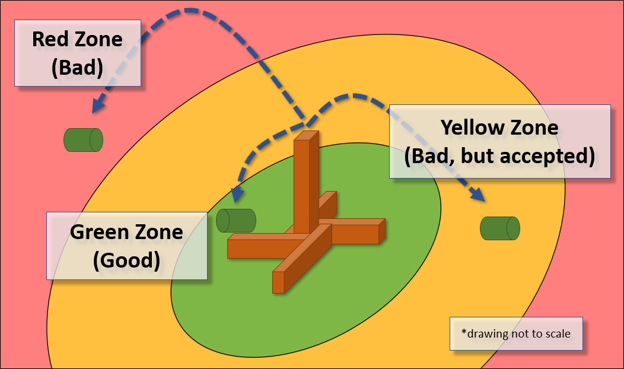
- The zone deduction is assessed based on the position at which the tatami first comes into contact with the ground (i.e. rolling after contact does not impact the score).
- In the event that a clearly defined piece cannot be identified, the cut will be assumed to have landed in the red zone.
- Should a cut spray debris, it will be assumed to have landed in the red zone.
- Should a piece land straddling two zones, it will be assessed as landing in the lower deduction zone.
- [X] Scallop Example↓
A scallop is defined as a cut which clearly curves its trajectory in the tatami mat. This also applies to any parallel mat cuts which do not have the two cuts in the same line.

- [X] Large Mountain Example↓
A mountain is when a cut intersects a previous cut or cut attempt. This is penalized because the competitor no longer needs to cut through the full width of the target, and also because it demonstrates poor targeting and control. Cuts with mountains of greater than 1" (25.4 mm) will be awarded no points.

- [X] Tatami Surface Not In Line With Cutting Plane Example↓
This is a phenomenon that can occur with extremely sharp swords which are highly optimized for cutting. If the tatami ends up cut on a different plane than the one on which the sword was swung, it indicates that the competitor performed a "failed" cut, but that their sword was able to overcome this and still pass through the thin tatami targets.
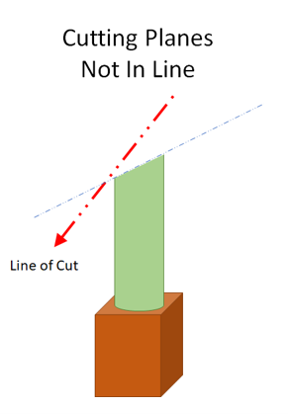
- [X] Cut Below Limit Example↓
The lowest rubber band on the tatami mat will indicate the lowest height a competitor may cut at. Any cuts that pass below this line will receive no points. Should the competitor hit the stand or floor, they will receive no points for the cut and instead have a value of -10 applied to their overall score.
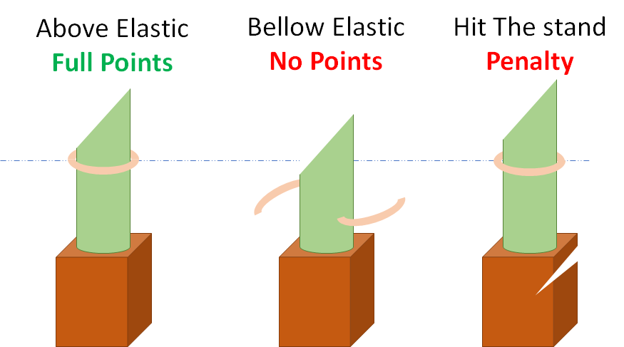
- [X] Failed Cut
- [X] Wrong Cut
Form Deductions
- [-3]: Chambering Examples↓
- If the lead foot lands and is firmly plated while the sword is being chambered/accelerated.
- If the sword has a large motion pulling backwards as part of the approach/cut.
- If there is a noticeable delay when executing cuts that must flow in sequence.
- [-3/-5/-7]: Off Balance Example↓
- Exposing the full side or back while completing the cut.
- Being unbalance on landing, and needing extra effort to stabilize the body, or needing extra steps to regain balance.
- [-5]: Entering Waiting Area as Signal Period Ends* Example↓
- Reactive cutting round only.
- [X]: Not In Waiting Area* Example↓
- Reactive cutting round only.
- Not In Waiting Area When Signal Period Ends
- Not In Waiting Area When Signal Period Ends
- [X]: Starting Close / Not Stepping Example↓
- Measuring up
- Not stepping with a cut
- Starting so close that no step is required
- Resetting before executing a cut that must be done in a fluid sequence
Penalties
If a penalty occurs during the Cut and Form deductions will not be considered, and instead a negative score will be given for the cut.
- [X/X/-0]: Cutting Over Lead Leg (zero points for the cut, second offense is a DQ)
- [-5] Hit the Stand
- [-10] Hit the Floor lightly
- [DQ] Hit the Floor hard, or a second time
- [DQ] Releasing the sword (including release from a single hand in longsword)
- [DQ] Second warning for cutting over the lead leg, if not allowed by the tournament.
Any other infractions such as not listening to tournament staff, unsportsmanlike conduct, etc will be dealt with according to the discretion of the tournament staff. (We've never had to deal with this, please don't make us.)
Example Score Calculations
| Cut | Form | Score |
|---|---|---|
| -0 | -0 | 10 |
| -3 | -0 | 7 |
| -0 | -7 | 3 |
| -5 | -5 | 2.9 |
| -3 | -7 | 2.4 |
| -10 | -0 | 0 |
| -10 | -7 | 0 |
Paper Deductions
Paper cutting will be performed on a vertical hanging paper. The paper offers lower resistance than tatami, but can rip more easily and tests for a much larger cutting line.
Each paper cut, without deductions, is worth a base of 4 points. Scoring differences are noted here. (All deductions that are obviously specific to the nature of a tatami mat are not relevant).
Cut
- [-1]: Roughness Example↓
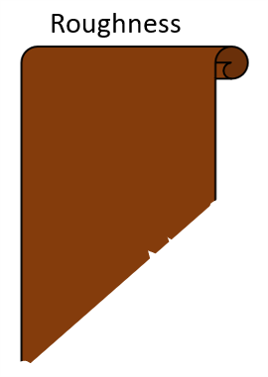
- [-1]: Paper Flutter
- [-2]: Small Rip Example↓

- [-2]: Small Scallop Example↓

- [-2]: Sound of impact or strong paper flutter
- [X]: Extremely loud impact sound and violent paper movement.
- [X]: Ripped Paper Example↓
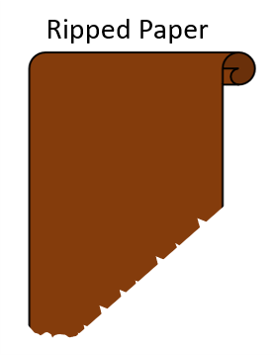
- [X]: Large Scallop Example↓
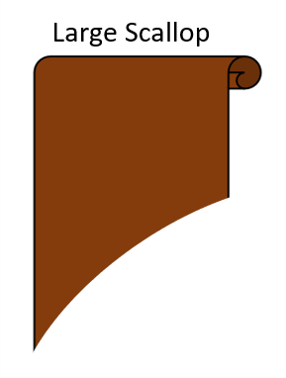
Form
- All deductions less than 5 points will be 1 point
- All deductions equal to or greater than 5 points will be 2 points.
Competitor Conduct
Competitors shall not begin cutting until instructed to do so by the tournament staff. Following the completion of each cut, the competitor must wait for confirmation from the cutting judges before beginning their next cut. After assessing the quality of a cut, the cutting judges will hold up a color-coded card to provide feedback to the cutter and the audience and to indicate that the competitor may make their next cut. A competitor may not address the table to inquire about a score which has been awarded. These cards will be:
- Green - No point deduction on cut
- Yellow - Point deduction on cut
- Red - No points awarded on cut
- Verbal Warning - Penalty assessed
Should a competitor request a mat straightening (provided the round allows for it), they must first step out of the cutting area with the tip of their sword pointed toward the ground. The competitor must not move until instructed to do so by the tournament staff.
Competitors that take excessive time to begin after they have been signaled to cut will be warned by the tournament staff, and may be subject to penalties if there are repeated infractions. While it is not necessary for a competitor to rush after they are prompted, it is intended that they perform the cut in a short period of time without spending considerable time fidgeting or psyching themselves up.
During reactive cutting rounds, the competitor must wait in an area designated by the tournament staff. Only once the cut has been signaled may they move forward and execute their cut. The competitor must then return to the waiting area before the signaling period has concluded or be assessed a point deduction on the cut.
































